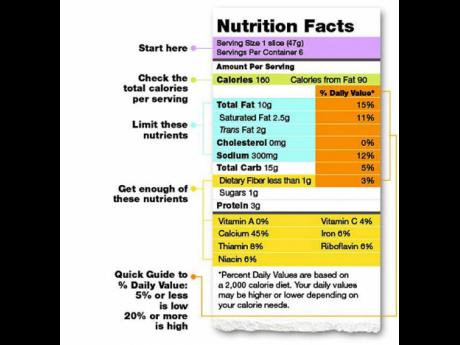The basics of the nutrition facts label
The nutrition facts label tells you what is in the food you are eating. It helps you determine if you have a healthy, balanced diet. Every packaged or processed product should have a label.
Dr Rivane Chybar Virgo, medical doctor and health and wellness coach, said it can be difficult to read food labels. However, all the other information on the label relates back to the serving size.
“It is an important skill to master reading nutrition facts label because we will know the foods that we are putting into our bodies. By reading the ingredients section, we will know the nutritional value, and it also tells us what we are eating in one sitting. So, it is crucial to take a step and check what is in our foods,” Dr Chybar Virgo said.
Serving size is the first piece of information listed on the label. This is the amount of food that is typically eaten at one time. The size is in a basic household measurement, such as pieces, cups, or ounces.
“Serving size is an important factor in your diet. You should compare the amount of that food you normally eat to the serving size listed on the label. Eating large servings or portions can lead to weight gain. The larger your portions are, the more calories you eat,” Dr Chybar Virgo said.
The nutrition facts apply to the serving size, so if the serving size is one cup and you eat two cups, you are getting twice the calories, fat and other nutrients than what is listed on the label.
The label also provides a column of percentages called the per cent daily value. It compares how much of a nutrient is in one serving of food to how much of that nutrient you should consume in one day.
The percentages are based on a daily diet of 2,000 calories. You will need to adjust the amounts if you eat more or less than 2,000 calories per day. Everyone has different calorie needs. These depend on your gender, age, and activity level.
“Use the percent daily values to help evaluate how a particular food fits into your daily meal plan. Some ingredients, such as saturated and trans fats, are unhealthy. You only should eat these in small amounts. A serving with five per cent or less of the daily value is low. A serving with 20 per cent or more of the daily value is high,” Dr Chybar Virgo said.
You get your daily calories from what you eat and drink. A healthy person should consume nutrients from the five basic food groups – fruits, vegetables, grains, protein, and dairy.
“Eating less saturated fat, added sugars and sodium may help reduce your risk for chronic disease. Saturated fat and trans fat are linked to an increased risk of heart disease. Eating too much added sugars makes it difficult to meet nutrient needs within your calorie requirement. High levels of sodium can add up to high blood pressure. Remember to aim for low percentage daily value of these,” Dr Chybar Virgo said.
He suggested that persons should choose more foods containing dietary fibre, potassium, vitamin D, calcium and iron to maintain good health and help reduce your risk of certain health problems such as osteoporosis and anaemia.
“Choose more fruits and vegetables to get more of these nutrients. Remember to aim high for percentage daily value of these nutrients on other foods,” she said.



